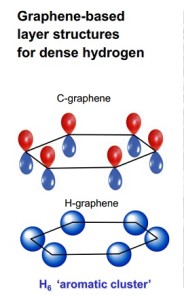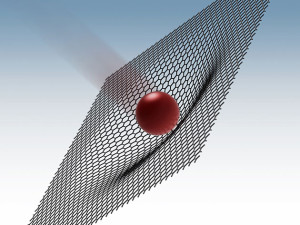 Host: Board on Chemical Sciences and Technology, National Academies of Sciences, Engineering, and Medicine (NASEM)
Host: Board on Chemical Sciences and Technology, National Academies of Sciences, Engineering, and Medicine (NASEM)
Date: Thursday, July 21, 2022
Time: 1300-1400h EDT
Cost: Free and open to the public

A comparison of the basic ring structure of the carbon compound graphene with that of a similar hydrogen-based structure synthesized by Carnegie scientists.
Credit: Carnegie Science
A new study shows remarkable parallels between hydrogen and graphene under extreme pressures.
The study was conducted by Carnegie’s Ivan Naumov and Russell Hemley, and can be found in the December issue of Accounts of Chemical Research.
Because of hydrogen’s simplicity and abundance, it has long been used as a testing ground for theories of the chemical bond. It is necessary to understand chemical bonding in extreme environments in order to expand our knowledge of a broad range of conditions found in the universe.
It has always been difficult for researchers to observe hydrogen’s behavior under very high pressure, until recently when teams observed the element at pressures of 2-to-3.5 million times the normal atmospheric pressure.
Under this pressure, it transforms into an unexpected structure that consists of layered sheets, rather than close-packed metal – which had been the prediction of scientists many years ago.

Madeleine Jacobs, Chief Executive Officer and Executive Director of the American Chemical Society.
Credit: Peter Cutts
Madeline Jacobs has held steadfast to the idea of improving lives through the transforming power of chemistry during her career. Now, after seeing all she set out accomplish during her time as the American Chemical Society’s director and chief executive officer come to fruition, Jacobs is ready to move on to something new.
Jacobs started her career with the American Chemical Society (ACS) as a reporter for Chemical & Engineering News in 1969. Here, she rose in the ranks – becoming the magazine’s editor-in-chief in 1995.
Her work at Chemical & Engineering News prepared her for the role that she would take on in 2003 as ACS’s executive director.
A recently conducted experiment may give us a better understanding of how the Earth possibly began.
Scientists took to the lab with a powerful 500-foot laser to re-create what might have been the original spark of life on Earth.
This from Associated Press:
The researchers zapped clay and a chemical soup with the laser to simulate the energy of a speeding asteroid smashing into the planet. They ended up creating what can be considered crucial pieces of the building blocks of life.
The image to your right may look like a fine art print of an ocean scene at night, but it’s actually just a close-up of some dried Glenlivet 162, or for those of you who aren’t avid alcohol connoisseurs – it’s simply a photo of whiskey.
Maybe “simple” is not the best word to describe the chemical process that takes place, but the discovery that whiskey can make these beautiful images had a humble beginning.
Professional artist and photographer Ernie Button started creating photos of the patterns formed after letting a drop or two of whiskey dry at the bottom of a glass, which resulted in these clear and rhythmic images.
Though he loved the aesthetic value, Button wanted to understand why the images looked the way they looked.
A new chemical sponge out of the University of Nottingham has the potential to lessen the carbon footprint of the oil industry.
Professor Martin Schröder and Dr. Sihai Yang of the University of Nottingham led a multi-disciplinary team from various institutions, which resulted in the discovery of this novel chemical sponge that separates a number of important gases from mixtures generated during crude oil refinement.
Crude oil has many uses – from fueling cars and heating homes to creating polymers and other useful materials. However, the existing process for producing this fuel has not been as efficient as it could possibly be.

The ballistic test shows that graphene is excellent at both absorbing and spreading the energy of an impact.
Credit: Jae-Hwang Lee
We’ve been talking a lot about graphene – from its potential in energy storage to its ability to improve and revolutionize personal electronic devices, this material seems to be everywhere. Now, engineers out of the University of Massachusetts believe it could help save lives.
Engineers developed a mock-up of multilayered graphene body armor and tested it in a miniature shooting range. The results suggest that graphene may be able to absorb 10 times the amount of energy that its steel competitor can before failing.

Find openings in your area via the ECS job board.
ECS’s job board keeps you up-to-date with the latest career opportunities in electrochemical and solid-state science. Check out the latest openings that have been added to the board:
Postdoctoral Research Associate in Chemical Engineering
Case Western Reserve University – Cleveland, Ohio
The Postdoctoral Research Associate will conduct research and development on titanium electrowinning from molten salts. Technical responsibilities will include high-temperature electrochemical reactor design and fabrication, experimental investigations of electrodeposition from molten salts, and some mathematical modeling studies.
ECS’s job board keeps you up-to-date with the latest career opportunities in electrochemical and solid-state science. Check out the latest openings that have been added to the board:
Post-Doctoral Research Associate
North Carolina State University – Raleigh, North Carolina
The Postdoctoral Research Associate will focus his/her work on research and development of new lithium-sulfur batteries. The work includes the development of both electrode and electrolyte materials and the integration of these materials into lithium-sulfur batteries. The Postdoctoral Research Associate will be responsible on designing and carrying out experiments, analyzing data, writing reports, and/or help mentoring junior researchers to conduct their research.


